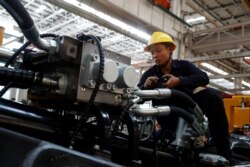China’s industrial output grew significantly slower than expected in October, as weakness in global and domestic demand and the drawn-out Sino-U.S. trade war weighed on activity in the world’s second-largest economy.
Industrial production rose 4.7% year-on-year in October, data from the National Bureau of Statistics released Thursday showed, below the median forecast of 5.4% growth in a Reuters poll.
Indicators showed other sectors also slowing significantly and missing forecasts with retail sales growth back near a 16-year trough and fixed asset investment growth the weakest on record.
Disappointing data
The disappointing economic data adds to the case for Beijing to roll out fresh support for the economy after China’s economic growth slowed to its weakest pace in almost three decades in the third quarter as the bruising U.S. trade war hit factory production.
Broad activity in China’s manufacturing sector remains weak with data over the weekend showing factory gate prices falling at their fastest pace in more than three years in October.
China’s official Purchasing Managers’ Index (PMI) also showed activity in the factory sector remained in contraction for a sixth straight month.
“Admittedly, optimism surrounding a phase-one U.S.-China trade deal could provide a boost to corporate investment in the near term,” Capital Economics China Economist Martin Lynge Rasmussen said.
“But even if a minor deal is agreed upon in the coming months, this would merely allow the focus to shift to the more intractable issues that we think will eventually lead the trade talks to break down. The case for further monetary easing remains intact,” he added.
Other data Thursday showed China’s property investment growth in the first 10 months of the 2019 slowing year-on-year.
Trade war hits global demand
The tariff war between China and the United States has hit global demand, disrupted supply chains and upended financial markets.
While some signs of recent progress in trade negotiations between the superpowers have cheered investors, officials from both sides have so far avoided any firm commitments to end their dispute.
That uncertainty has continued to weigh on manufacturers and their order books.
Thursday’s data also showed fixed asset investment, a key driver of economic growth, grew 5.2% from January-October, against expected growth of 5.4%. The January-October growth was the lowest since Reuters record began in 1996.
Private sector fixed-asset investment, which accounts for 60% of the country’s total investment, grew 4.4% in January-October.
On Wednesday, China’s State Council said Beijing would lower the minimum capital ratio requirement for some infrastructure investment projects.
Retail sales rose 7.2% year-on-year in October, missing expected growth of 7.9% and matching the more than 16 year low hit in April.
Consumers have been hit with higher food prices over the past few months, as pork and other meat prices soared.
At the same time, consumers have been reluctant to make big purchases with auto sales falling for the 16th straight month in October, data showed Monday.










